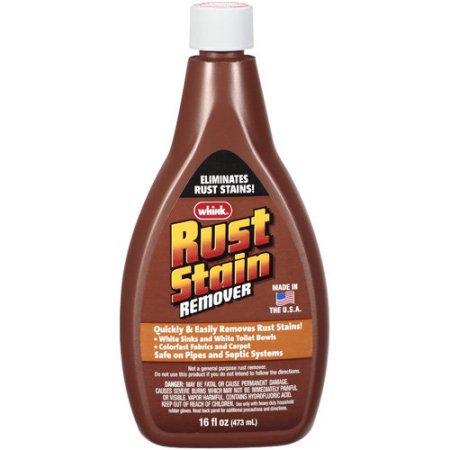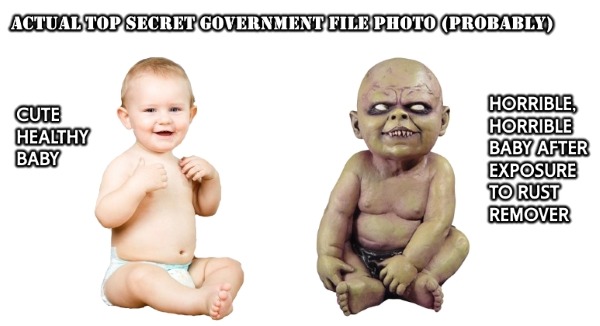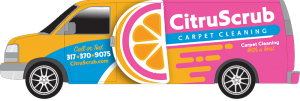Think reading is for chumps? Skip the article and watch this video!
I’m about to tell you how to use a chemical that’s so insidious, so dangerous, so profoundly EVIL… you must double-dog pinky-swear that you won’t kill yourself using it. Or, at the very least, lose a finger. Or an eye.
If you’ve ever tried to get a rust stain out of your carpet, you know it’s impossible. And why is it impossible?
It’s impossible because there is one–ONE–chemical that removes rust stains. And no, you probably don’t have it just sitting around the house.
It’s not vinegar. It’s not ammonia. It’s not lemon juice.
What you need is a product called… wait for it… WAAAIIITTT FOR IT…
It’s called “rust remover”. Yes, “rust remover”. I’m not sure who came up with that clever name, but that’s what it’s called.
To be exact, what you want is a brand name called Whink, which you can find at Walmart and most grocery stores. (I’ve looked for it at Lowe’s at Home Depot, but I’ve never found it at either place.)
It comes in an ugly brown bottle, like so:

Don’t let the innocuous sounding name or cutesy label fool you–this stuff is extremely dangerous. PLEASE be careful with it and use at your own risk. I accept no responsibility if you or someone you love is injured. You’ve been warned.
And no, I’m no joking.
The active ingredient is hydrofluoric acid. It’s highly corrosive and causes horrific injuries. Don’t google the pictures. You’ll be sorry you did.
What’s especially evil about this stuff is the way it interferes with your nerve functions. Basically, it deadens pain so you have no idea it’s ravaging your skin. Sometimes, it can take up to a day for the damage to become evident.
If you get this stuff all over yourself, you could wake up in the morning with terrible chemical burns. Please–PLEASE–be careful.
Every professional carpet cleaner has heard horror stories about hydrofluoric acid. Evidently, some pros have lost fingers and large chunks of flesh because they didn’t realize the acid was eating through their flesh.
Again, I’m not joking. If you use this stuff, PLEASE be careful. Follow the directions on the label with great care.
I would recommend rubber gloves and eye protection.

But the evil doesn’t stop there… Rust remover is somewhat difficult to rinse out of carpet. If you don’t get it all out, the leftover residue dries into a dormant crystalline substance that becomes reactivated the next time it encounters moisture.
And guess what. Human skin contains enough moisture to reactivate it. Yes, the mere act of stepping or crawling on dried, dormant rust remover with bare skin can reactivate it.
Therefore, it’s imperative you rinse this stuff very thoroughly, especially if you have kids or pets who are active on the carpet. Capiche?
Now, here’s how you use it…
First of all, you absolutely MUST have a Shop-Vac to do this. Do NOT attempt the following without a Shop-Vac.
So here’s what you do… Locate the rust stain on your carpet. Squirt some Whink on it, straight out of the bottle. It has a nice little squirty-spout-opening-thingy, which is nice.
Give the chemical a minute to dwell. In the meantime, do NOT inhale the fumes. If your rust stain is small, it won’t be a problem. But I’ve seen huge rust stains–for instance, from the bottom of a metal file cabinet–that require tons of rust remover. In those cases, make sure the room is well ventilated, because the amount of chemical you’ll need will put off some serious fumes.
A word of warning about the fumes… You may not smell anything. But that doesn’t mean there are no fumes. Trust me, the fumes are there. Don’t put your face directly over the work area, especially if you’re using a large amount of chemical. Those fumes will be coming right at you.
Onward…
If the rust stain is stubborn, try gently kicking it with the toe of your shoe. You’ll see the rust start to disappear before your eyes.
So far, this is the easy part. The hard part is rinsing away the rust remover.
That’s why it’s imperative to have a Shop-Vac. It’s the only way you’ll be able to extract all the chemical.
When the stain is completely gone, suck the excess chemical out with your Shop-Vac. Then saturate the area with water and suck that out too. Then saturate again, and extract again. I’d saturate and extract at least two or three times to make sure all the rust remover has been rinsed out.
Some rust stains are more difficult to remove than others. You may have to repeat the above steps more than once. But, as a common rule, rust stains always come out.
If you encounter a rust stain that won’t budge, it’s probably not rust. It might be varnish from a chair leg or something. If the stain doesn’t obviously respond within seconds of applying rust remover, it’s probably not rust and it’s probably permanent.
Most rust stains I’ve seen are about the size of a dime or less. As long as you follow the directions on the label and exercise caution, it is very safe for you, the do-it-yourselfer, to remove stains of that size.
However, if you have a large stain–anything larger than about a quarter–use extra caution. Be mindful of fumes, and make sure you rinse out all the chemical.
When you’re done, wash your hands thoroughly to make sure there’s no rust remover on your skin. Remember, it could start to eat away at your flesh, and you might not even feel it.
Have I warned you enough? The truth is, you’ll probably be fine tackling rust stains on your own. I’ve been using rust remover almost every day for 20 years, and I still have all my fingers.
(Side note, I’m also just as devastatingly handsome as I was 20 years ago. See for yourself…)

But I still want you to be careful, mkay?
I have one last tip for you before I let you go… I have a customer who’s a retired biochemist. He lives just north of downtown Indy–very cool guy with a lovely wife and family.
Anyway, he once told me that he removed a rust stain from his carpet with vitamin C. Yep, just a regular ol’ vitamin C tablet dissolved in a glass of water.
I won’t pretend to understand the chemistry because I’m just an old rug scrubber, but evidently, vitamin C somehow counteracts rust and makes it disappear.
It must work on the same principle as hydrofluoric acid, only slower. He told me it took repeated applications over the course of several hours before his rust stain disappeared. But if you’re looking for a safe DIY option, it might be sitting in your medicine cabinet.
Of course, if you live in the greater Indy area and you’d rather have a pro take care of your stains, just give the ol’ Rosster a call and I’ll get you fixed up. Call or text me at 317-370-9075. If email is your jam, click here to send a message.
Thanks for reading. Until next time!








